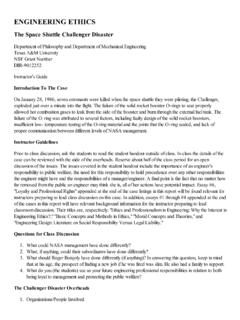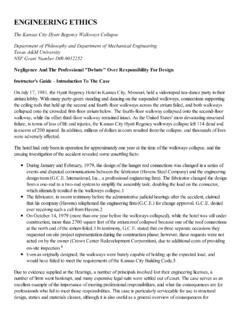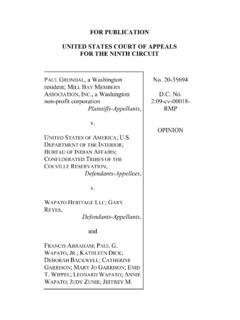Transcription of Engineers And The Environment - Texas A&M University
1 Engineers And The Environment (ESSAY #7)IntroductionEngineering responsibility for the Environment is necessarily closely related to the laws governing environmentalmatters, but environmental degradation was not the subject of serious federal regulation until the late 1960' that time, private litigation and the common law were the principal tools for controlling pollution. Usually,however, no single individual was sufficiently harmed by pollution to be motivated to bring suit against a the states and the Federal government were ineffective in controlling a response to this state of affairs, Congress passed the National environmental Policy Act (NEPA) in Act inaugurated "a national policy which will encourage productive and enjoyable harmony between manand his " One of the best-known provisions of the NEPA is the requirement for an environmentalimpact statement, which enumerates the effect of a project on the Environment .
2 Congress then created theEnvironmental Protection Agency (EPA) to enforce its mandates. In the ensuing decades Congress enactedlegislation to control pollution in four major order to protect the air, Congress enacted the Clean Air Act of 1970 and amended it in 1977. The Act set agoal of a 90% reduction for auto emissions. It permitted the EPA to consider economic and technologicalfeasibility in deciding when the goals were to be met, but not in adjusting the goals 1979, the EPA adopted a "bubble" concept as a method of enforcement. According to this policy, animaginary "bubble" is placed around a plant or even an entire region. Under the bubble concept, industries mayreduce those emissions which they can reduce most cheaply.
3 One plant may be able to reduce pollutant A morecheaply, even reducing the level below the minimum level required by law. Another plant may be able to reducepollutant B more cheaply, reducing it below the level required by law. Then the two plants can engage in trades,whereby the first plant trades some of the "credits" it has in pollutant A for some of the "credits" the second planthas in pollutant B. Since the first plant can reduce pollutant A most efficiently and the second plant can reducepollutant B most efficiently, the total level of pollution under the bubble can be reduced to designated levels, butin the most economically efficient 1972 Congress enacted the Clean Water Act and amended it in 1972, 1977, and 1986.
4 The Act, designed to"restore and maintain the chemical, physical, and biological integrity of the Nation's waters," makes it unlawful forany person, business, or governmental body to discharge any pollutant into navigable waters without a Act mandated pollution control measures in two stages. By 1977 all plants were to have installed waterpollution control devices that represented the best practicable pollution control technology. By 1989 all plantswere to have installed equipment that met more stringent standards. Plants discharging conventional pollutants areto apply the best conventional pollutant control technology. Plants discharging toxic or unconventional pollutantsare to apply the best available technology economically 1976 Congress enacted the Resource Conservation and Recovery Act (RCRA), designed to control thetransportation, storage, treatment, and disposal of hazardous wastes.
5 The Act requires the generator of ahazardous waste to complete a "manifest," a form that describes the nature of the hazardous waste and itsmethod of disposal. The transporter must sign the manifest and the operator of the disposal site must do so aswell, returning the manifest to the generator of the waste. This procedure is supposed to provide a completerecord of the disposal of the waste. The EPA is also required to regulate the disposal sites order to facilitate the cleanup of inactive dump sites, Congress enacted the Comprehensive EnvironmentalResponse, Compensation, and Liability Act in 1980. The Act empowers the President to clean up abandonedhazardous sites and to provide necessary remedial actions in the case of , Congress has enacted a number of other laws which require businesses to alter products and processesthat can have an adverse effect on the Environment .
6 The Noise Pollution Control Act of 1972 gives the federalgovernment broad powers to protect the public from excessive noise. The Federal Insecticide, Fungicide, andRodenticide Act of 1947 and the Federal environmental Pesticide Control Act that amended it requiresmanufacturers to register insecticides with the EPA before they can be sold to consumers. The EPA will registera pesticide only if it is properly labeled, does what it claims to do, and will not produce "any unreasonable risk toman or the Environment , taking into account the economic, social and environmental costs and benefits of the useof any pesticide." The Toxic Substances Control Act (TOSCA) of 1976 establishes a regulatory mechanism forprotecting the public against dangerous chemical materials contained in consumer and industrial are the principal federal laws that provide the legal context in which decisions regarding the effect oftechnology on the Environment must be made.
7 Many decisions are not covered by the laws, however, so there isthe need for individual judgment. These judgments are usually made by business managers, so the attitudes ofmanagers toward environmental laws is also important for Managers and environmental LawsA recent survey gives us insight into the attitudes of managers towards environmental laws. From 1982 until1985 joseph M. Patulla, Director of the Graduate Program in environmental Management at the University ofSan Francisco, surveyed a number of industries with respect to hazardous waste disposal. He found that hecould classify the companies he investigated into three categories. The first type of company, consisting of 29%of the firms surveyed, engaged in what Petulla called "crisis-oriented environmental management.
8 " Industries inthis group tended to have no full-time personnel assigned to environmental concerns, devoted as few resourcesas possible to such matters, and fought environmental regulations. As one representative of this group put it,"Why the hell should we cooperate with government or anyone else who takes us away from our primary goal(of making money)?"1 He went on to say that it is cheaper to pay the fines and lobby than to devote resources toenvironmental second group, consisting of 58% of the firms surveyed, adopted what Patulla called "cost-orientedenvironmental management." Firms in this group accepted governmental regulation as a cost of doing business,but often without enthusiasm or commitment. They usually had established company policies regulating theenvironmental matters and separate units devoted to third group, consisting of 9% of Petulla's sample, adopted what he called "enlightened environmentalmanagement.
9 " In these companies, responsiveness to environmental concerns had the complete support of theCEO. The companies had well-staffed environmental divisions, used state-of-the-art equipment, and generallyhad good relationships with governmental regulators. One manager said that people in his company sawthemselves as good neighbors in the community. "Anyhow," he concluded, "in the long run it's in our own interest,to keep us from lawsuits and generate some good will."2 Petulla's findings must be viewed in the light of the fact that many of the attitudes expressed concernedenvironmental laws and their enforcement and may not have reflected fundamental attitudes towardsenvironmental matters accurately. Many of the managers in the second group may have had a commitment toenvironmental preservation, but they may have believed that governmental regulations are an inefficient way toprotect the Environment .
10 Nevertheless the survey suggests that relatively few managers have a firm commitmentto preserving the Codes and the EnvironmentIn the light of widespread skepticism on the part of managers, what are the responsibilities of professionalengineers with regard to the Environment ? The first canon of the NSPE code requires Engineers to "holdparamount the safety, health and welfare of the public in the performance of their professional duties." Insofar asenvironmental issues have a clear relation to human safety and health, therefore, the engineering profession hasalready committed itself to a concern for environmental protection and perhaps even improvement. For example, Engineers already have an obligation to concern themselves with pollution, when it affects human codes give little direction, however, as to how this concern should be implemented.










